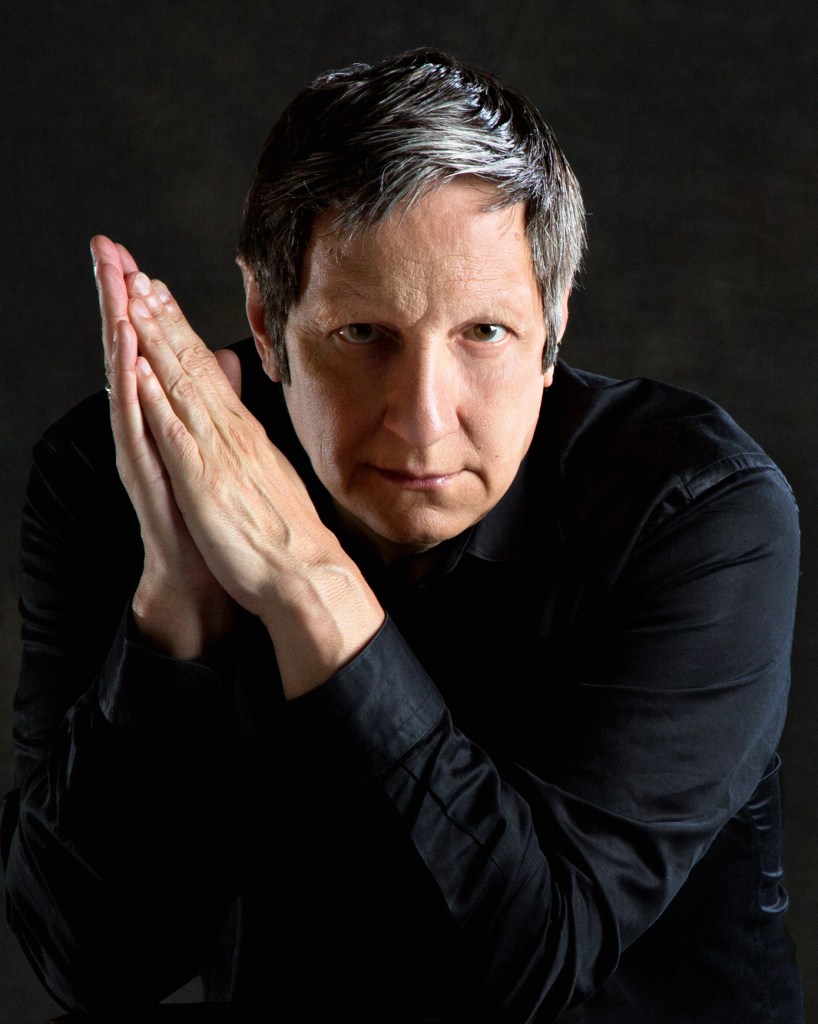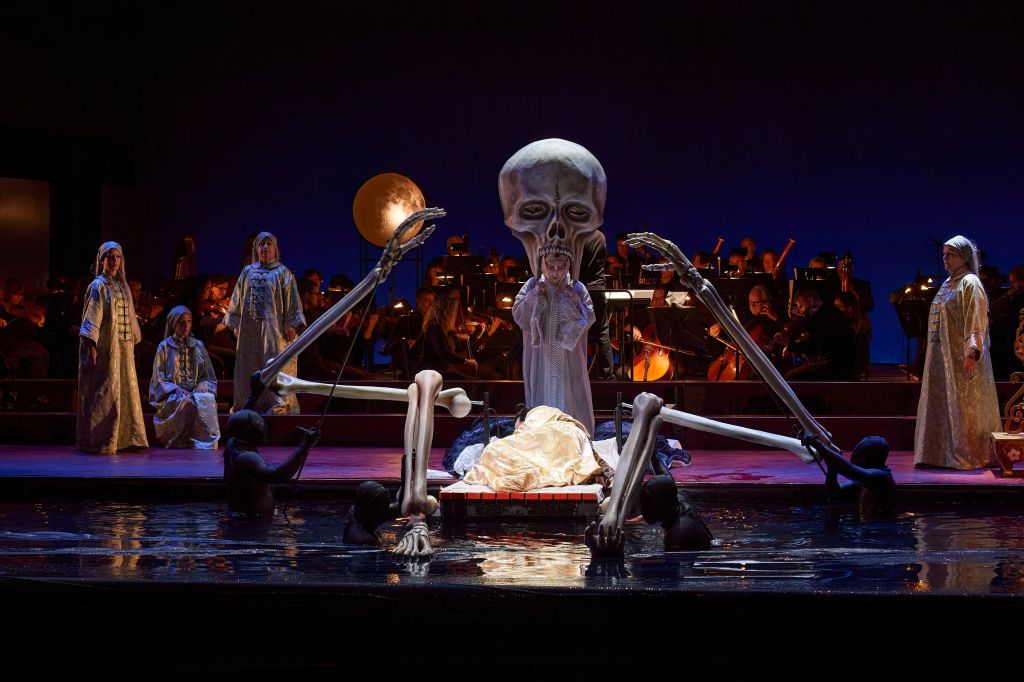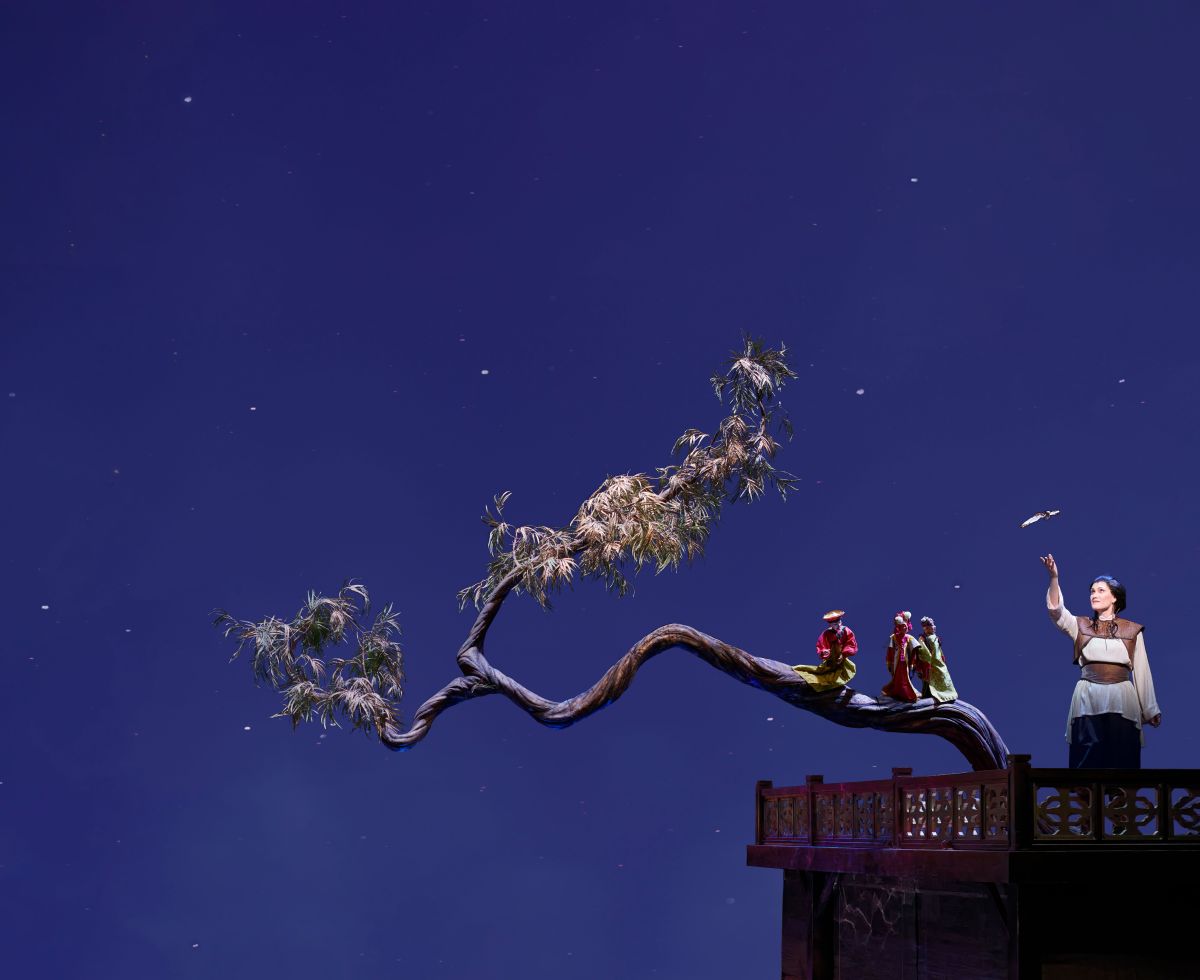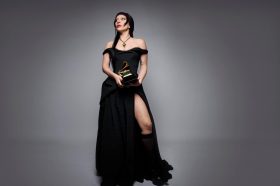White actors who imitate Asians dress up in bizarre yellowface make-up and chinoiserie-style costumes. They do an orientalised interpretation of puppetry filled with stereotypical motifs and move across a stage portraying “The Orient” based on 19th century Europeans’ exotic fantasies.
That outlandish spectacle fills the promotional materials for Adelaide Festival’s upcoming centrepiece performance, Igor Stravinsky’s The Nightingale and Other Fables. Directed by the esteemed Robert Lepage from Ex Machina, the opera has faced much past criticism and is based on an 1843 fairytale about an ancient Chinese emperor banishing a nightingale.
While Adelaide Festival’s questionable depictions aren’t uncommon – with Orientalism normalised and common onstage – it is nevertheless vital to understand its historical context and detrimental implications for Asian Australian representation.
In this article:
Orientalism in opera
Orientalism is ‘the way that the West perceives of – and thereby defines – the East’, according to Edward Said who coined the term. Not limited to opera, but also prevalent in ballet, theatre and cinema, exoticised stories about Asia have been used to entertain Western audiences since the 17th century, proliferating especially in the 18th to 20th centuries.
The practice coincides with, and is inextricably tied to, European colonialism, reflecting how the West viewed and made sense of non-whites. Jacqueline Lo, director of the Indo-Pacific Research Centre and pioneer of Asian-Australian studies, says, ‘It’s not just about the Orient; it is a construction that tells us more about the European Western self than any factual reality about the Other.’
This Western construction manifests itself in Orientalist opera’s unequal power dynamics, as explained by Caitlin Vincent, University of Melbourne’s Head of Arts and Cultural Management, whose expertise lies in opera.
Vincent explains that Europe’s fascination with seemingly “far-off lands” resulted ‘in hundreds of operas that relied on recurring character tropes (for example, the cruel Dragon Lady, the villainous Fu Manchu, the shy China Doll or Lotus Blossom), and exotic plot lines (such as the colonial man who falls in love with the “exotic” woman who then sacrifices herself for him).
‘A number are still actively performed by opera companies worldwide. Overall, roughly a third of the most popular “canonical” operas have themes of exoticism, including works like Madama Butterfly, Turandot, Carmen and The Abduction from the Seraglio,’ Vincent continues.
A significant aspect of Orientalist theatre is chinoiserie – 17th to 19th century European style imitations of Chinese designs that involves exoticising various Asian cultures and ignorantly reducing them to a monolith. It also often relies on yellowface to make non-Asian performers appear Asian, including through make-up, costumes or physicality that accentuates stereotypically Asiatic features.
Read: Why are we giving shows like Miss Saigon a rerun in 2023?
Harm of Orientalism
Lo explains that yellowfacing is ‘one of the mechanisms by which the “Western and European” makes sense and depicts the other, and therefore speaks for them in its construction. Historically, you can go back to aligning it with blackface… It is equally about an asymmetrical power relationship where the Western/European self depicts and speaks for the other’.
Vincent adds, ‘For the majority of opera’s history, yellowface was linked to the strict exclusion of performers of colour from operatic stages… In the present day, yellowface remains prevalent in opera in Australia, the US and Europe.
‘Numerous studies have shown the extent to which creatives of colour, particularly Asian singers, are actively excluded from opportunities to perform in Western opera productions. Opportunities are generally limited to a handful of Asian-specific roles (like Cio-Cio-San in Madama Butterfly), with far fewer chances to perform in traditionally “White” roles,’ Vincent continues.
Lo highlights a panel discussion in which actor Kenneth Moraleda explained how, even when Asian Australians score limited roles, they are often stereotypical and carry yellowfacing antecedents. She says a ‘deep hurt develops because, in one sense, you’re still complicit in those constructions and exoticisation, but those are the only roles available, and if you don’t take it yellowfacing will continue’.
Lo echoes the pain it causes the Asian community, often associated with deep social and psychosocial damage, especially to those in the industry who must work every day to put on the depictions, but also the audience ‘who would feel uncomfortable, unhappy and sometimes angry’.

Unpacking Lepage and ‘The Nightingale’
As an Orientalist opera, The Nightingale is no stranger to controversy, having been accused of cultural insensitivity and exoticisation many times before. The story presents problematic tropes, exemplifying a fascinating but backwards Asia with an incompetent emperor where Asian women are fetishised as docile and obedient.
Notably, a 2012 LaJolla Playhouse production of The Nightingale in the US caused a nationwide backlash from Asian Americans, with smaller productions, like one in Thornton, also causing scrutiny for its lack of Asian casting.
Robert Lepage, the director of Adelaide Festival’s production, also has a history of causing widespread condemnation against his intercultural works. In 2018, two of his productions were cancelled: Kanata for having no Indigenous cast and SLĀV for having primarily white actors sing slave songs.
In Lepage’s many previous productions of The Nightingale worldwide, yellowface was extensive and chinoiserie remains a key part of the allure. After analysing the Adelaide Festival’s 2024 production credits, one can find that most, if not all, the cast and team are also non-Asian.
Lo says that Orientalism at its worst ‘is what you see with… The Nightingale where you clearly have non-Asians in bizarre make-up, acting in highly offensive, stereotypical ways’.
She explains that Lepage’s The Nightingale is a classic example of intercultural theatre, productions often led by a Western director that incorporate and mix elements from different performing traditions worldwide.
‘A whole body of scholarship for the last 30 years has critiqued interculturalism precisely because of its asymmetrical power relations,’ adds Lo.
She continues, ‘Lepage has used Vietnamese puppetry and Taiwanese shadow puppets, but where are those practitioners? Are they actually the ones creating that imagery on stage, or is it Lepage’s production company? So, it’s not just the cultural appropriation of something, it’s the agency that I would challenge – who’s doing the work, who has the control and who benefits ultimately from the use of these performing traditions and representations?’
Read: Hindu leader decries ballet production
Vincent also questions The Nightingale, adding that to judge whether the production is harmful requires consideration of how it will be interpreted onstage, including creative choices made by the director and designers.
‘For any historical production that draws on Orientalist themes, it’s really important to first consider how the production is being staged for a modern day audience. Is the production design perpetuating an historical worldview that can be seen as exoticising and dehumanising certain cultures? The second thing to consider is who is actually being hired for these productions. Who are the performers that have been cast to play these roles? Who has been hired to direct and design the production on stage?’ she asks.
‘Are we seeing physical caricatures such as gratuitous, bowing “chopstick fingers” and other gestures that have been traditionally associated with negative stereotypes of Chinese people onstage? Are the costumes and staging choices exacerbating problematic caricatures … and, perhaps most importantly, does the production design rely on yellowface?’ Vincent continues.
Lo says, ‘Performing bodies like the Adelaide Festival need to be held accountable for the kinds of representations they celebrate onstage, and they need to take into account the scholarship and critique of intercultural works… The usual claim that opera is not realistic, and is a fantastical world that they’re presenting onstage, does not hold water anymore in 2024 multicultural Australia.’
Leading a change
Orientalist theatre undoubtedly causes harm to Asian Australian communities and pressuring for change is necessary.
Lo explains, ‘It’s a highly … ambivalent space that I think Asian Australian actors continue to occupy, and the only way of making that change is to create our own stories and to be in charge of our own depiction and representation.
‘It’s about educating people. I think directors need to understand that history and how to engage critics, people in the industry and the larger audience’, she continues.
Vincent suggests a re-evaluation of the current model of “colour-blind” casting that often results in mostly white performers for Asian-identified roles, which is problematic when the production design actively promotes an Asian cultural aesthetic.
‘For a production like The Nightingale, the question to ask is whether the production design is actually “colour-blind”, or whether it appears to prioritise Asian appearances for its characters through costumes and make-up. And, if the aesthetic of an Asian appearance is indeed critical to the production design, then it’s important to ask whether Asian-appearing performers would actually have been the “best singers” for those roles,’ she says.
Lo highlights that another important way to lead change is for audiences and industry workers to be more vocal. ‘Both allies and Asian Australians need to be much more aware and more networked in order to make change happen,’ she says.
She also notes, however, that ‘when Asian Australians do speak up or when there is critical commentary coming from the arts community, it gets a little bit of oxygen in the press or the social media space, but we do not hold decision-making bodies to account, and the press goes to the next big story. There’s no accountability’.
This was particularly the case with Cat-Thao Nguyen’s 2022 op-ed about Turandot’s yellowface, which generated much discussion but resulted in no public statement from Opera Australia.
A key move many theatre companies are utilising to claim they are being culturally sensitive is to engage cultural consultants. However, the advice is often ignored, as was the case with Lepage, who hired black and Indigenous cultural consultants for SLĀV and Kanata, but whose advice was ultimately disregarded.
Lo explains, ‘[The cultural consultants] give very good advice [but] it’s used as a “tick and flick” exercise because directors ultimately don’t have to take on board the advice. I don’t believe that the advice from Asian Australian advisers, if they’re even put in place, is often taken as seriously. It’s great that some decision-making bodies require cultural advisers, but that alone is not enough, especially if there is no requirement for accountability.’
Lo also emphasises, ‘I don’t think there’s a one-size-fits-all. I’m not promoting a cancel culture approach, and I’m highly critical of it in fact. I am asking for a much more informed way of producing these representations and the opportunity for Asian Australians to have agency when telling our stories on the mainstage.’

Ex Machina’s response
‘Why in the 21st century in 2024 is that kind of performance still celebrated as the opening act for Australia’s longest-serving arts festival, given that nearly 18% of the population now has Asian heritage?’ This is a question many Asian Australians, including Lo, have.
She continues, ‘I would be very interested to see what can they do with the yellowfacing, unless they actually have Asians to perform those roles. They cannot get away from it, can they? They’re using puppets with a particular kind of Peking opera make-up, which is then replicated in the actors and the singers. So, what will they do about those performing traditions they’ve deployed?’
Ex Machina’s Communications Coordinator Nina Lauren provides some information about the company’s casting and aesthetic choices.
‘Robert Lepage and his team are very much looking forward to bringing The Nightingale and Other Fables to the 2024 Adelaide Festival – a celebration of the arts renowned for its embrace of cultures from around the world,’ she tells ArtsHub.
‘Robert is committed to ensuring that, in this production, Asian culture and other cultures are respectfully represented and there have been numerous reflections and discussions with his artistic collaborators throughout the course of its creation and subsequent evolution. The creative team recognises that representing characters from different cultural backgrounds requires understanding, sensitivity and detailed research in order to marry the world of imagination and the reality of making theatre in the current time.
‘As times have changed and the conversation around cultural authority has developed, Robert Lepage and his team have recognised that there were aspects of the original production that would need adjustment to more properly respond to the cultural sensitivities of current times.
‘Whereas the original production used stylised make-up inspired and based on the puppets being utilised in the production, Robert and his team have now modified the make-up and wigs for the performers in The Nightingale to remove any sense of an attempt to make non-Asian performers appear to be Asian. The neutrality of the make-up design is designed to ensure that the performers simply serve the narrative as singers and puppeteers rather than representing any ethnicity.’
Whether Ex Machina’s efforts will make The Nightingale any more culturally appropriate remains to be seen, and controversy is bound to arise given the casting choices amid Orientalist themes.
Nevertheless, we must continue to pressure Australian arts institutions to start fostering authentic Asian representation, rather than ridicule.
This article is published under the Amplify Collective, an initiative supported by The Walkley Foundation and made possible through funding from the Meta Australian News Fund.




